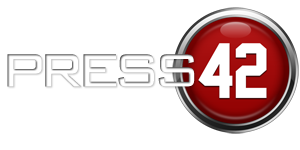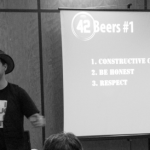42 Beers and wonder woman

First of all, thank you very much to everyone that came to the event this week. Glad to see so many known faces and people that came back for more after the first 2 editions.
This time we had two very interesting startups, Qrystal, former Tetuan Valley alumni and Ducksboard, one of the hottest startups in Spain right know and which recently raised 600k€. I want to personally thank both Chris and Marta from doing the effort of going on stage to get whacked.
There where very interesting discussions during this edition, these are some of the points that where raised and that we’ll try to get better next time:
- When presenting your startup, make sure you explain or show in a clear way what does your product does. How does it fixes or alleviates the problem. The goal isn’t to go deep into the technology, but just to give a walk through how do you solve it. Many times, startups use to many PR words or vague expressions to define what they do, for example: social, local, platform, cross-selling, etc. You should try to avoid them as much as possible, be concise and specific.
- Slides structure is a big problem for some startups. You have to be careful on how do you plan which information show first. To some extend, a presentation is like a storyboard of a movie. In a movie, it makes no sense to show all the cast at the beginning an then narrate the story. That’s what happened during this edition, one of the startups showcased the team at the very beginning, even before talking about the pain points, the problem or the solution. If you hijack the train of thought of the audience, you’ll loose them for sure. Try to mimic what a regular person would be thinking while watching at it step by step.
- Speaking of which, be careful with the amount of time you spend talking about a specific slide. Sometimes we focus on a specific topic because for us, the startup, that part has been particularly painful or we feel especially proud of it. For example, during this edition one of the teams spent 3 minutes talking about the team. While is good to give an intro to the team, it’s not the top priority of the audience at that point. If you combine this with the fact that it was presented at the very beginning of the presentation, it makes even less sense. This is the magic of timing. If you introduce a very complex problem first, then and only then I’m very interested on knowing if your team is suited for that. Then and only then I’ll decide to believe or not in your endeavor.
- Video or no video, that is the question. Someone from the audience asked this interesting question. Should you or shouldn’t you feature a quick video on your product? Personally I recently saw the guys at istv.pl do a pitch with a video. I did enjoyed it, but to be honest, a video is something I look at when I don’t have someone to explain it to me. It’s a substitute. I would rather listen to the founder describing the problem than a non-interactive video. That being said, if the video complement what you’re saying, by all means, use it. The key here is the word, complement, not substitute. Also, careful with demos, videos or anything that requires to be tested before hand. Murphy’s law exists for a reason.
- Looks phony. Some startups use mockups for their designs when they haven’t gotten any prototype yet. Some use them even when they have a lousy prototype. It’s preferable to show a crappy prototype screenshot than a shinny mockup. The reason is, people will identify your shinny mockup with something phony. They’ll think you don’t have anything at all and that you’re selling snake’s oil. So if you have something, please do show it!
- As usual, be extremely careful with the amount of text some of your slides contain. If you add too much text, the following will happen: you’ll be tempted to read it, the audience will be tempted to read it and in consequence, they’ll loose attention and ignore you.
- Sometimes startups add slides that they don’t talk about. Don’t do that. No one forces you to add specific terms or words to your slides so make sure that if you’re not going to go over that, you don’t show it. If you show it, either it’s self explanatory, like platform-supported icons, or you go over the terms.
- Avoid inventing terms, especially when you’re presenting on a language that isn’t your mother tongue. Always double check that that smart term you just invented doesn’t exists or if it does, it means what you are intending it to be.
- Disconnected stories. When adding stories to your presentation, make sure you run them through the whole presentation, not just on a specific part. Not only that, make sure the storyline evokes the right images in the audience. If telling multiple stories, always remember to connect them so the flow doesn’t breaks and the transition is natural. This week I told 2 stories that, violated just exactly this, they evoked a specific idea that I later discarded creating a cognitive dissonance within the audience. Also, both stories I told where disconnected so the audience had a bumpy ride to go from one to the other one.
- Being brave and bold: Love, Sex, American express. I think the moment where we had the most heated discussion was when I showed a picture of a sexy super woman. For some people in the audience, this wasn’t appropriated. I knew this was going to be the case but I still ran with it. The reason is that, adding controversial slides is a great way of getting people to remember you. Such slides must be tailored for the specific audience, to resonate with the majority (In my case, a male audience). Do you take a risk? Definitely. Is it worth it? Definitely. The key here is realizing the amount of people you’ll alienate with this particular slide. If you aren’t good at planning this estimation you shouldn’t do it. But if you are and if the odds of alienating part of the audience are very small, then do it, you’ll stand out and rise above the average presentations. The thing is, you will never please everyone. This is a profound truth you need to fully understand. If you take that as your base line, then it’s easy to take such risks, as you know you’ll always have haters in the audience, no matter what.
- If your startup uses a new technology and that is key to your proposition, make sure you nail this. Show the audience how the technology works in a plain language or super simple example. Then tell them why this technology and not others is the best choice; what is so special about this one? i.e is cheaper, faster, safer, etc. Finally, make sure you show the audience data to back your claims. Graphs and percentages of usage traction, use cases, etc. of that particular technology will take you a long way. The thing is, humans are inherently curious, so when fed a new thing they’ll want to satiate that curiosity. Be careful though, this doesn’t means you need to go all technical on them either.
These are just some of the points we discussed this week. If you attended and what to share what you learned (kudos to Pablo for his post here), please do so in the comments so we can enrich the post.
Finally, if you liked the event, check out our PR, Communication and storytelling workshop where we’ll go deep into how to deal with the media, how do they think and how to send them beautifully crafted stories.
Here are my versions of the slides:



















